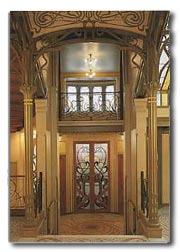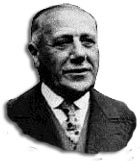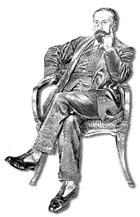Contents
Baron Victor Horta was born in Ghent, Belgium in 1861.
He studied drawing, textiles, and architecture at the Academy of Beaux-Arts in Ghent, then went to Paris to work.
He then returned to Belgium and drafted for Classical architect Alphons Balat.
In 1890, Victor Horta set up his own firm.
In 1893 he designed what is widely regarded as the first architectural expression of mature Art Nouveau, namely Tassel house in Brussels.
His innovative use of exposed ironwork and open-plan space characterised Horta as one of the pioneers and leading practitioners of art nouveau architecture.
He abandoned the neo-classical style of his schooling years in favour of an innovative art nouveau approach that built on irregular shapes and lush curved lines.
His first major work, Hotel Tassel (1892-1893), in Brussels, set forth his principal themes:
He used exposed cast iron as a structural material; produced a centralized floor plan in place of the traditional corridor arrangement; and paid close attention to ornamentation.
He supervised the interior decoration and even the furniture design in all of all his buildings
His characteristic flowing whiplash lines, inspired by vegetation, were prominent in his wall decorations, doors, and staircases
The Horta lines are exemplified in his most lavish private house, now the Hotel Solvay (1894) in Brussels.
In public buildings such as the Maison du Peuple (1899, destroyed 1964), the Brussels headquarters of the Belgian Socialist party, he produced glass and iron facades that were some of the most advanced of the day.
The many works of Victor Horta include:
- 1889 - LAMBEAUX SCULPTURE PAVILION. Brussels
- 1890 - MATTYN HOUSE. Brussels
- 1892 - TASSEL HOUSE. 1892-3. Brussels
- 1893 - AUTRIQUE HOUSE. Brussels
- 1894 - FRISON TOWN HOUSE. Brussels
- 1894 - WISSINGNER HOUSE. 1894-03. Brussels
- 1895 - HOTEL SOLVAY. Brussels
- 1895 - HOTEL VAN EETVELDE. 1895-98. Brussels
- 1896 - MAISON DU PEUPLE. 1896-8. Brussels
- 1898 - HORTA HOUSE. now MUSEE HORTA. Brussels
- 1901 - A L'INNOVATION DEPARTMENT STORE. 1901-3. Brussels
- 1902 - BELGION PAVILION, INTERNATIONAL EXPOSITION OF DECORATIVE ARTS. Turin
- 1902 - MONUMENT TO BRAHMS. Vienna
- 1903 - GRAND BAZAAR DEPARTMENT STORE. Frankfurt
- 1903 - WAUCQUEZ DEPARTMENT STORE. 1903-5. Brussels
- 1903 - HALLET HOUSE. Brussels
- 1906 - WOLFERS BUILDING. Brussels
- 1906 - BRUGMANN HOSPITAL. 1906-26. Brussels
- 1914 - HALLE CENTRAL, MAIN RAILWAY STATION. 19144-52. Brussels
- 1925 - PALAIX DES BEAUX-ARTS, EXPOSTITION DES ARTS DECORATIFS. Paris
- 1928 - MUSEUM OF FINE ARTS. Doornik
Baron Victor Horta art nouveau designs were an important European predecessor of the modern 20th-century International Style, particularly his use of exposed structural ironwork and glass facades.




Leave a Reply
You must be logged in to post a comment.